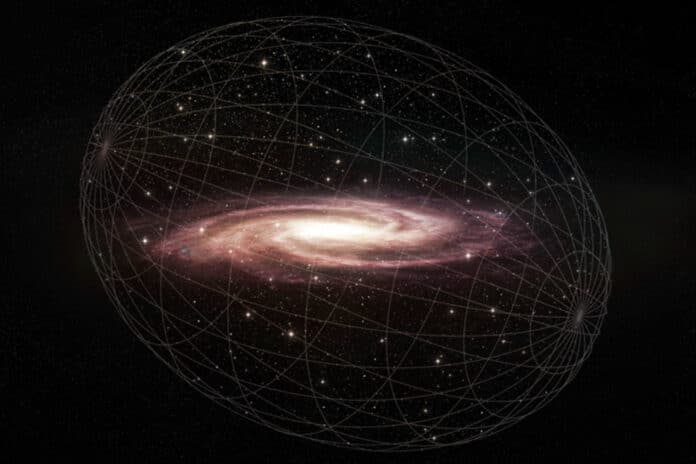A new study has offered significant insights into a host of astrophysical subject areas, as it reveals the true shape of the diffuse cloud of stars surrounding the disk of our galaxy.
This cloud of stars, known as a stellar halo, was believed to be largely spherical. According to a new model, this stellar halo is oblong and tilted, much like a football that has just been kicked.
The results shed light on the history of our galaxy and galactic evolution while offering clues in the ongoing hunt for the mysterious substance known as dark matter.
Study lead author Jiwon “Jesse” Han, a Ph.D. student at the Center for Astrophysics | Harvard & Smithsonian, said, “The shape of the stellar halo is a fundamental parameter that we’ve just measured to greater accuracy than was possible before. There are a lot of important implications of the stellar halo not being spherical but instead shaped like a football, rugby ball, or zeppelin — take your pick!”
Study co-author Charlie Conroy, Han’s advisor and a professor of astronomy at Harvard University and the Center for Astrophysics, said, “For decades, the general assumption has been that the stellar halo is more or less spherical and isotropic, or the same in every direction. We now know the textbook picture of our galaxy embedded within a spherical volume of stars must be thrown out.”
But because we are a part of the Milky Way, it has been difficult for astronomers to understand the form of its stellar halo. The stellar halo surrounds our Solar System and reaches out several hundred thousand light years above and below the star-filled plane of our galaxy.
Han said, “Unlike with external galaxies, where we look at them and measure their halos. We lack the same aerial, outside perspective of our own galaxy’s halo.”
Further complicating matters, just around 1% of the galaxy’s total star mass is found in the stellar halo, which has turned out to be rather diffuse. The stars that make up this halo are many, but through time, astronomers have identified many of them. These stars may be distinguished from other Milky Way stars by their unique chemical makeup and their distances and motions across the sky. These investigations have shown astronomers that the distribution of halo stars is not uniform. Since then, the objective has been to investigate the spatial patterns of star over-densities, which manifest as bunches and streams, to determine the true origins of the stellar halo.
The second dataset is from H3 (Hectochelle in the Halo at High Resolution). H3 has gathered detailed observations of tens of thousands of stellar halo stars too far away for Gaia to assess.
The non-spherical halo was produced by combining these data in a flexible model that allowed the star halo form to emerge from all observations; the football shape fits in well with previous discoveries. For instance, the shape independently and substantially supports a prominent theory on how the stellar halo of the Milky Way was created.
According to this framework, the stellar halo formed when a lone dwarf galaxy collided 7-10 billion years ago with our far-larger galaxy. The departed dwarf galaxy is amusingly known as Gaia-Sausage-Enceladus (GSE), where “Gaia” refers to the aforementioned spacecraft, “Sausage” for a pattern appearing when plotting the Gaia data, and “Enceladus” for the Greek mythological giant who was buried under a mountain — rather like how GSE was buried in the Milky Way.
Due to this galactic collisional event, the dwarf galaxy was ripped apart, and its constituent stars sprayed out into a dispersed halo. Such an origin story accounts for the stellar halo stars’ inherent unlikeness to stars born and bred in the Milky Way, which led to the extra shedding of GSE stars. Meanwhile, the tilt of the stellar halo indicates that GSE encountered the Milky Way at an incident angle and not straight-on.
Conroy said, “The tilt and distribution of stars in the stellar halo provide dramatic confirmation that our galaxy collided with another smaller galaxy 7-10 billion years ago.”
Scientists noted, “Notably, so much time has passed since the GSE-Milky Way smashup that the stellar halo stars would have been expected to dynamically settle into the classical, long-assumed spherical shape. The fact that they haven’t likely speaks to the broader galactic halo. This dark matter-dominated structure is probably askew and, through its gravity, is likewise keeping the stellar halo off-kilter.”
Conroy said, “The tilted stellar halo strongly suggests that the underlying dark matter halo is also tilted. A tilt in the dark matter halo could significantly impact our ability to detect dark matter particles in laboratories on Earth.”
Identifying the star halo’s most likely configuration can advance numerous astrophysical studies and provide fundamental information about our place in the cosmos.
Han said, “These are such intuitively interesting questions to ask about our galaxy: ‘What does the galaxy look like?’ and ‘What does the stellar halo look like?'”
“With this line of research and study, we are finally answering those questions.”
Journal Reference:
- Jiwon Jesse Han et al. The Stellar Halo of the Galaxy is Tilted and Doubly Broken. The Astronomical Journal. DOI: 10.3847/1538-3881/ac97e9
